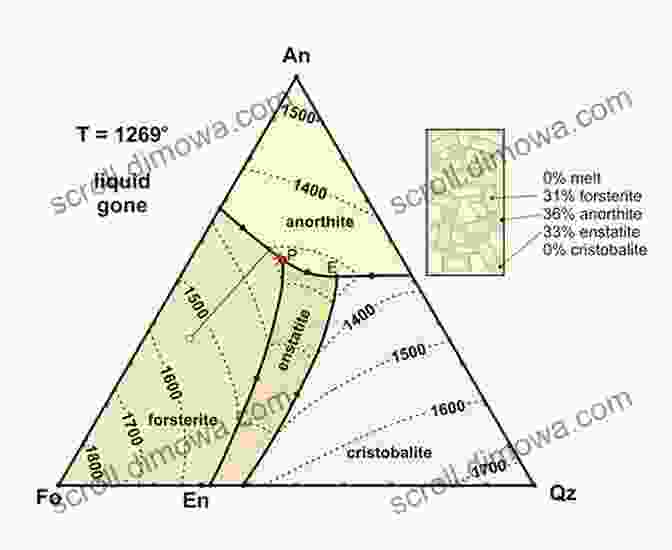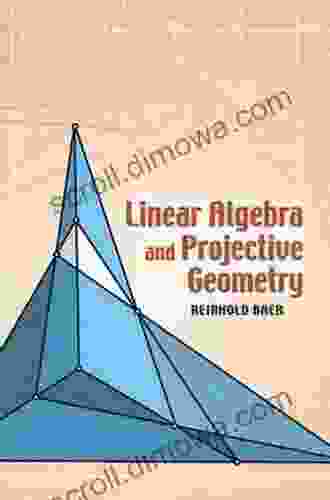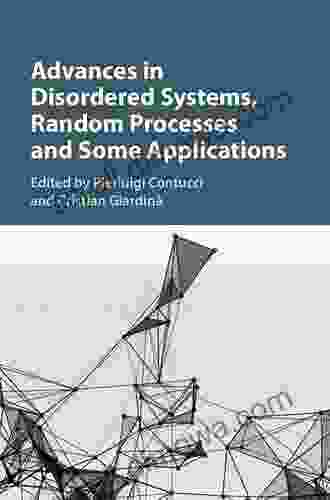Unveiling the Secrets: A Comprehensive Guide to Ternary Phase Diagrams in Materials Science

Phase diagrams are powerful tools that provide a graphical representation of the thermodynamic behavior of multi-component systems. Among them, ternary phase diagrams are particularly valuable in materials science, as they depict the phase equilibria of systems with three components. Understanding these diagrams is crucial for predicting the behavior of complex materials, designing new alloys, and optimizing materials processing.
5 out of 5
| Language | : | English |
| File size | : | 10265 KB |
| Text-to-Speech | : | Enabled |
| Enhanced typesetting | : | Enabled |
| Print length | : | 231 pages |
| Screen Reader | : | Supported |
This comprehensive guide will unravel the intricate world of ternary phase diagrams. We will delve into the fundamental principles, explore practical applications, and introduce advanced techniques that elevate the understanding of materials behavior. Buckle up and prepare to unlock the secrets of these invaluable tools in materials science.
Principles of Ternary Phase Diagrams
Phase Equilibria and Thermodynamics
Ternary phase diagrams are constructed based on the principles of thermodynamics and phase equilibria. The diagram represents the conditions under which different phases (e.g., solid, liquid, gas) coexist in equilibrium. Each phase is represented by a distinct region on the diagram, and the boundaries between these regions indicate the conditions at which phase transformations occur.
The shape and topology of a ternary phase diagram are primarily determined by the interactions between the components. These interactions can be expressed in terms of free energy, enthalpy, and entropy, and they govern the stability of different phases.
The Gibbs Phase Rule
The Gibbs phase rule provides a fundamental relationship between the number of components (C),phases (P),and degrees of freedom (F) in a system:
F = C - P + 2
For a ternary system (C = 3),the number of degrees of freedom is:
F = 5 - P
This implies that in a ternary phase diagram, three phases can coexist in equilibrium at a single point, known as a triple point. At a triple point, the system has no degrees of freedom, and the composition and temperature are fixed.
Interpreting Ternary Phase Diagrams
Composition Coordinates
Ternary phase diagrams are typically plotted using equilateral triangles. Each vertex of the triangle represents a pure component, and the interior of the triangle represents all possible combinations of the three components. The composition of a point within the triangle is expressed in terms of the mole fractions or weight percentages of the three components.
The sides of the triangle represent binary systems, and the interior of the triangle represents ternary systems.
Phase Boundaries
Phase boundaries on a ternary phase diagram indicate the conditions under which two or more phases coexist in equilibrium. The type of phase boundary depends on the number of phases involved:
- Two-phase boundaries: Represent lines or curves that separate two phase fields.
- Three-phase boundaries: Represent points (triple points) where three phase fields intersect.
- Four-phase boundaries: Represent lines or curves where four phase fields meet (very rare).
Invariant Points and Lines
Invariant points and lines are special features on ternary phase diagrams that represent conditions where the number of degrees of freedom is reduced.
- Triple points: Invariant points where three phases coexist in equilibrium.
- Invariant lines: Lines where three phases coexist in equilibrium over a range of compositions.
Applications of Ternary Phase Diagrams in Materials Science
Alloy Development
Ternary phase diagrams are essential for developing new alloys with specific properties. By understanding the phase equilibria of different alloy systems, materials scientists can design alloys that meet the desired performance requirements.
For example, ternary phase diagrams have been used to develop high-strength steels, corrosion-resistant alloys, and shape-memory alloys.
Phase Transformations
Ternary phase diagrams provide insights into the phase transformations that occur in materials during processing or service. By tracking the changes in phase composition and temperature, materials scientists can optimize heat treatments and other processing parameters to achieve the desired microstructure and properties.
Phase diagrams are particularly useful for studying solid-state transformations, such as allotropic transformations and precipitation reactions.
Thermodynamic Calculations
Ternary phase diagrams can be used for thermodynamic calculations, such as determining the equilibrium compositions of multi-component systems and calculating phase equilibria.
These calculations are essential for process design and optimization in various industries, including metallurgy, ceramics, and polymer science.
Advanced Techniques in Ternary Phase Diagram Analysis
Computational Thermodynamics
Computational thermodynamics techniques, such as the CALPHAD (CALculation of PHAse Diagrams) method, enable the calculation and prediction of phase equilibria in complex multi-component systems.
These techniques use thermodynamic models and databases to generate ternary phase diagrams and predict the behavior of materials under different conditions.
Microstructural Characterization
Microstructural characterization techniques, such as electron microscopy and X-ray diffraction, can be combined with ternary phase diagrams to provide a deeper understanding of phase transformations and the relationship between microstructure and properties.
By correlating the observed microstructure with the phase diagram, materials scientists can identify the phases present, their compositions, and their distribution.
In situ Experiments
In situ experiments, such as high-temperature microscopy and synchrotron radiation diffraction, allow researchers to observe phase transformations in real-time.
By combining in situ experiments with ternary phase diagrams, scientists can gain insights into the kinetics and mechanisms of phase transformations, providing valuable information for materials design and processing.
Ternary phase diagrams are indispensable tools for understanding the behavior of complex materials. This comprehensive guide has provided an in-depth exploration of the principles, applications, and advanced techniques involved in ternary phase diagram analysis.
By mastering these concepts, materials scientists can unlock the secrets of materials behavior, design new alloys, optimize materials processing, and push the boundaries of materials science research and development.
Embrace the power of ternary phase diagrams and embark on a journey of discovery in the fascinating world of materials science.

5 out of 5
| Language | : | English |
| File size | : | 10265 KB |
| Text-to-Speech | : | Enabled |
| Enhanced typesetting | : | Enabled |
| Print length | : | 231 pages |
| Screen Reader | : | Supported |
Do you want to contribute by writing guest posts on this blog?
Please contact us and send us a resume of previous articles that you have written.
 Book
Book Novel
Novel Page
Page Chapter
Chapter Text
Text Story
Story Genre
Genre Reader
Reader Library
Library Paperback
Paperback E-book
E-book Magazine
Magazine Newspaper
Newspaper Paragraph
Paragraph Sentence
Sentence Bookmark
Bookmark Shelf
Shelf Glossary
Glossary Bibliography
Bibliography Foreword
Foreword Preface
Preface Synopsis
Synopsis Annotation
Annotation Footnote
Footnote Manuscript
Manuscript Scroll
Scroll Codex
Codex Tome
Tome Bestseller
Bestseller Classics
Classics Library card
Library card Narrative
Narrative Biography
Biography Autobiography
Autobiography Memoir
Memoir Reference
Reference Encyclopedia
Encyclopedia Judy Dodge Cummings
Judy Dodge Cummings Dennis Lindsey
Dennis Lindsey Cathy Bartel
Cathy Bartel Rick Telander
Rick Telander Darius Lahoutifard
Darius Lahoutifard Peter Shaw
Peter Shaw Doug Jordan
Doug Jordan Heather Demetrios
Heather Demetrios Mark Reps
Mark Reps Itamar Blauer
Itamar Blauer Catherine Linka
Catherine Linka Tim Anderson
Tim Anderson Eugene D Commins
Eugene D Commins Frank Morgan
Frank Morgan Dan Hill
Dan Hill Charlaine Harris
Charlaine Harris Cayla Kluver
Cayla Kluver Sheena Boekweg
Sheena Boekweg Pat Schmatz
Pat Schmatz Michael Langlois
Michael Langlois
Light bulbAdvertise smarter! Our strategic ad space ensures maximum exposure. Reserve your spot today!
 F. Scott FitzgeraldFollow ·8.7k
F. Scott FitzgeraldFollow ·8.7k Vince HayesFollow ·13.1k
Vince HayesFollow ·13.1k Holden BellFollow ·6.9k
Holden BellFollow ·6.9k Patrick RothfussFollow ·8k
Patrick RothfussFollow ·8k William ShakespeareFollow ·17k
William ShakespeareFollow ·17k Terry BellFollow ·9k
Terry BellFollow ·9k Chance FosterFollow ·12.8k
Chance FosterFollow ·12.8k Cody RussellFollow ·5.5k
Cody RussellFollow ·5.5k

 Lawrence Bell
Lawrence BellThe Life and Legacy of Voltaire: A Monumental Exploration...
Enlightenment...

 F. Scott Fitzgerald
F. Scott FitzgeraldThe Captain Quest: A Captivating Saga of Adventure,...
Prepare to embark on an...

 Gabriel Mistral
Gabriel MistralUnveiling the Secrets of Navigation and Map Reading: A...
: A World of...

 Steven Hayes
Steven HayesThe Lives and Legacies of John and John Quincy Adams: A...
John Adams and...
5 out of 5
| Language | : | English |
| File size | : | 10265 KB |
| Text-to-Speech | : | Enabled |
| Enhanced typesetting | : | Enabled |
| Print length | : | 231 pages |
| Screen Reader | : | Supported |
















